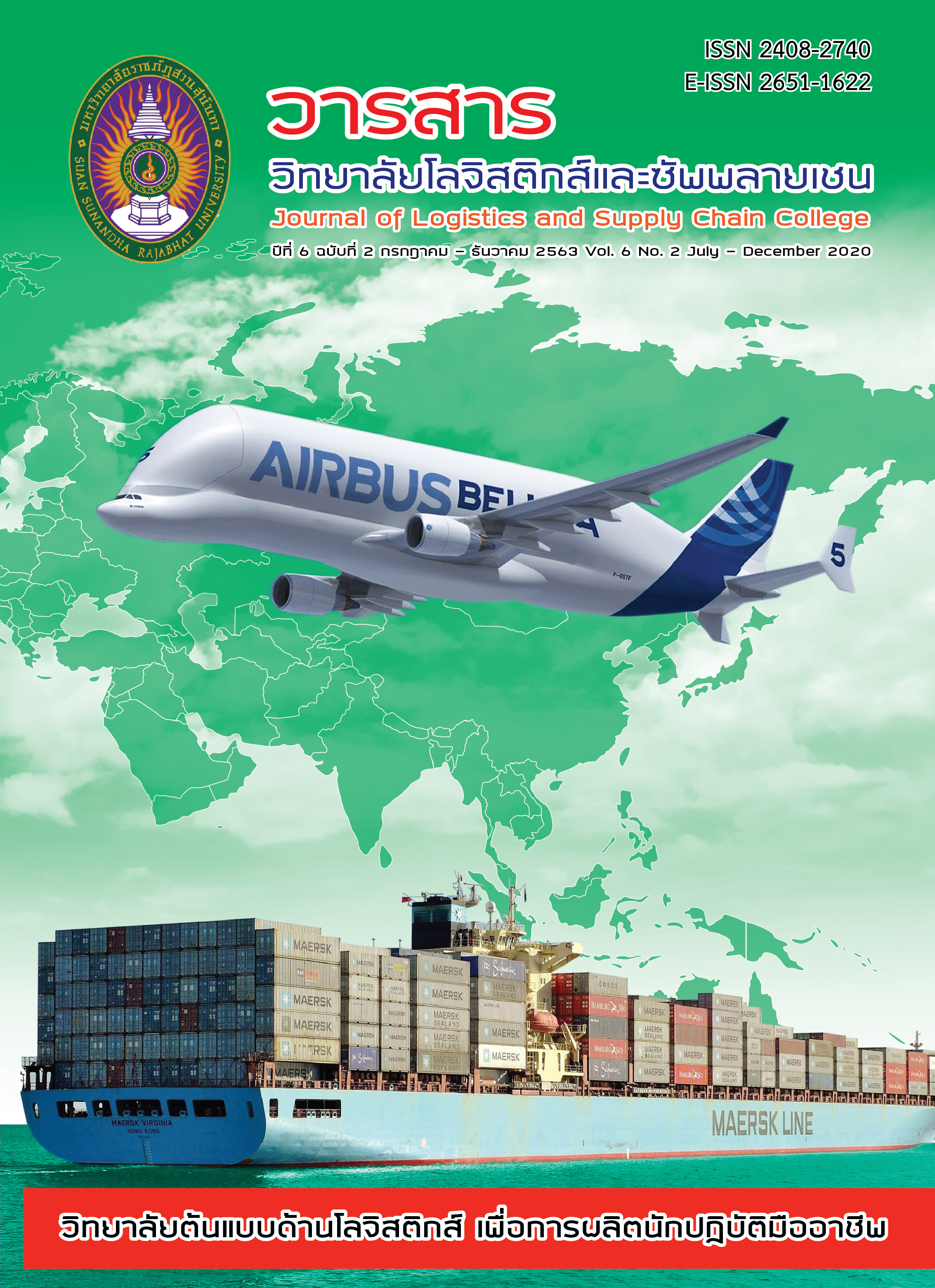กลยุทธ์ทางธุรกิจสำหรับการติดต่อกับลูกค้าที่ส่งผลกระทบต่อชื่อเสียงองค์กรของธุรกิจสายการบินในยุคประเทศไทย 4.0
บทคัดย่อ
การวิจัยครั้งนี้มีวัตถุประสงค์เพื่อตรวจสอบผลกระทบของกลยุทธ์ทางธุรกิจสำหรับการติดต่อกับลูกค้า ที่ส่งผลกระทบต่อชื่อเสียงองค์กรของธุรกิจสายการบินในยุคประเทศไทย 4.0 กลุ่มตัวอย่างที่ใช้ในการศึกษา คือ ลูกค้า อาศัยอยู่ในเขตกรุงเทพมหานครและปริมณฑล และเคยใช้บริการจากธุรกิจสายการบินในประเทศไทย จำนวน 350 คน ใช้แบบสอบถามในการเก็บรวบรวมข้อมูล วิธีการสุ่มตัวอย่างเป็นแบบเจาะจงและวิธีการสุ่มตัวอย่างที่สะดวก การวิเคราะห์ข้อมูลประกอบด้วยสถิติเชิงพรรณนา ได้แก่ ความถี่ ร้อยละ ค่าเฉลี่ย และส่วนเบี่ยงเบนมาตรฐาน และแบบจำลองสมการโครงสร้าง ผลการวิจัย พบว่า กลยุทธ์ด้านบุคลากรมีผลโดยตรงต่อกลยุทธ์ด้านการตลาดและกลยุทธ์ด้านการสร้างประสบการณ์ของลูกค้าและผลทางอ้อมต่อชื่อเสียงขององค์กรด้วยค่าสัมประสิทธิ์มาตรฐานที่ 0.790, 0.557 และ 0.605 ในขณะที่ กลยุทธ์ด้านการตลาดมีผลโดยตรงต่อกลยุทธ์ด้านการสร้างประสบการณ์ของลูกค้าและชื่อเสียงขององค์กรโดยมีค่าสัมประสิทธิ์มาตรฐานเท่ากับ 0.352 และ 0.321 ตามลำดับ สุดท้าย กลยุทธ์ด้านการสร้างประสบการณ์ของลูกค้ามีผลโดยตรงต่อชื่อเสียงขององค์กรโดยมีค่าสัมประสิทธิ์มาตรฐานเท่ากับ 0.283 ที่ระดับนัยสำคัญที่ 0.001 ซึ่งผลการศึกษาสามารถช่วยฝ่ายบริหารกำหนดและพัฒนากลยุทธ์ด้านบุคลากร กลยุทธ์ด้านการตลาด และกลยุทธ์ด้านประสบการณ์ของลูกค้าเพื่อสร้างชื่อเสียงที่ดีให้กับองค์กรในยุคประเทศไทย 4.0
เอกสารอ้างอิง
Abdelhady, M. R. R., Fayed, H. A. K., & Fawzy, N. M. (2019). The Influence of Airlines' Marketing Mix Elements on Passengers' Purchasing Decision-Making: The Case of FSCs and LCCs. International Journal of Hospitality & Tourism Systems, 12(2).1-16.
Ban, H. J., & Kim, H. S. (2019). Understanding customer experience and satisfaction through airline passengers’ online review. Sustainability, 11(15), 4066.
Baruch, Y. (1999). Response rate in academic studies-A comparative analysis. Human relations, 52(4), 421-438.
Cochran, W. G., & William, G. (1977). Sampling Techniques. New York: John Wiley& Sons.
Ejem, E. A., Dike, D. N., Okoroji, L. I., & Igboanusi, C. (2016). Exploratory factor analysis of human resources management strategies in the nigerian airline industry. International Journal of Research in management, Sicence & Technology, 5(1), 128-136.
Enz, C. A. (2002). From the Executive Director: Promoting the human spirit: Key to business success. Cornell Hospitality Quarterly, 43(4), 1.
Hajiar, S. T. (2014). A statistical study to develop a reliable scale to evaluate instructors within higher institution. WSEAS Transactions on Mathematics, 13, 885-894.
Hapsari, R., Clemes, M., & Dean, D. (2016). The mediating role of perceived value on the relationship between service quality and customer satisfaction: Evidence from Indonesian airline passengers. Procedia Economics and Finance, 35(12), 388-95.
Hooper, D., Coughlan, J., & Mullen, M. R. (2008). Structural equation modelling: Guidelines for determining model fit. Electronic journal of business research methods, 6(1), 53-60.
Judge, T. A., Thoresen, C. J., Bono, J. E., & Patton, G. K. (2001). The job satisfaction–job performance relationship: A qualitative and quantitative review. Psychological bulletin, 127(3), 376.
Mellat-Parast, M., Golmohammadi, D., McFadden, K. L., & Miller, J. W. (2015). Linking business strategy to service failures and financial performance: Empirical evidence from the US domestic airline industry. Journal of Operations Management, 38, 14-24.
Nikbin, D., Ismail, I., Marimuthu, M., & Abu‐Jarad, I. Y. (2011). The impact of firm reputation on customers’ responses to service failure: the role of failure attributions. Business Strategy Series, 12(1). 19-29.
Nulty, D. D. (2008). The adequacy of response rates to online and paper surveys: what can be done?. Assessment & evaluation in higher education, 33(3), 301-314.
Seo, E. J., & Park, J. W. (2017). A study on the impact of airline corporate reputation on brand loyalty. International Business Research, 10(1), 59-67.
Solimun, S. and Fernandes, A. A. R. (2018). The mediation effect of customer satisfaction in the relationship between service quality, service orientation, and marketing mix strategy to customer loyalty. Journal of Management Development, 37(1), 76-87.
Sukortpromme, S., Onputtha, S., & Jotikasthira, C. (2019). The Effect of Employee’s Knowledge Learning, Knowledge Sharing and Working Skill on Employee Value in Anonymous Tire Manufacturing Company, International Journal of Applied Computer Technology and Information Systems, 9(1), 29-37
Siljaru, T. (2012). Research and data analysis with SPSS and AMOS. Nonthaburi: S.R. Print and Mass Production.
Tabachnick, B. G., & Linda S. F. (2001). Principal components and factor analysis. Using multivariate statistics, 4, 582-633.
Tilley, S., & Houston, D. (2016). The gender turnaround: Young women now travelling more than young men. Journal of Transport Geography, 54, 349-358.
Tiwasing, A, Onputtha, S., & Boonrin, C. (2019). Relationship of Customer’s Behavior and Service Innovation on Customer Satisfaction towards Low-Cost Airline Business: A Case of Thai Air-Asia. Proceeding of The 15th National Conference and 2019-1 International Conference on Applied Computer Technology and Information Systems, and 2019-1 National Conference on Business Administration, 513-519.
Walsh, G., Dinnie, K., & Wiedmann, K. P. (2006). How do corporate reputation and customer satisfaction impact customer defection? A study of private energy customers in Germany. Journal of Services Marketing, 20(6), 412-420.
Wheaton, B., Muthen, B., Alwin, D. F., & Summers, G. F. (1977). Assessing reliability and stability in panel models. Sociological methodology, 8, 84-136.



